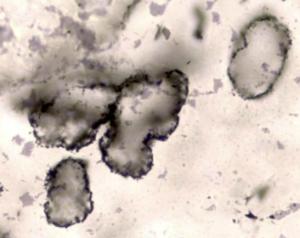
34亿年前的微体化石(图)
来自澳洲西部大学和牛津大学的科学家们最近在澳洲发现了到目前为止,地球上最古老的化石。这块只有使用显微镜才能观察的化石证实了在34亿年前的地球,细胞和细菌均生活在缺氧的环境中。
该研究发现的论文发表在了最新一期的《Nature Geoscience》杂志上。
研究的主要人员,牛津大学地球科学部的Martin Brasier教授说道:“现在我们终于找到了实际的证据,表明了在34亿年前,细菌生活在无氧的环境中。”
那个时期的地球还处于一个炙热、混乱的环境下。到处发生着火山喷发,天空是灰色的、乌云密布使得阳光照射不到大地。海洋的水温远高于40到50度——相当于一个洗热水澡的温度,而且环流非常强。所有的陆地都很小,或者和加勒比海大陆一样,并且潮水的范围非常广。
那个时期的一个主要特点是:环境中几乎没有氧气的存在,因为那时没有任何的植物或藻类可以进行光合作用产生氧气。现在最新的证据显示那时的生命以硫为基础,用硫化物进行代谢产生能量和生长。
这种以硫化物为代谢基础物质的细菌在如今仍然常见,它们通常在难闻的臭水沟、土壤、温泉和热流中——几乎在任何缺氧的地方,并且它们能在没有有机物存在的条件下生存。
Brasier教授说道:“我们非常确定这块化石距今的年限,它保存得相当完好,且形成于两个火山的喷发的间隔,因此可能在推断年限上仅有数千万年差异,推断该化石形成于34亿年前已经是非常精确的数值了。”
化石上有非常明显的类似细胞大小的结构,它们和之前已经发现的20亿年前的微体化石非常相似。
从化石中可以大致推断它们的生物学特性:这些细胞聚集生长,最重要的是它们显示出新陈代谢的功能,微小化石中细菌的化学合成部位在细胞结构的右侧,且化石上的黄铁矿晶体成分显示它们非常有可能是使用硫化物进行的新陈代谢。
Brasier教授说道:“我们现在正将它和之前发现的各个微化石进行仔细的比较,相信不久的将来会有更惊奇的发现。”(生物探索 Jun译)
生物探索推荐英文论文原文摘要:
Microfossils of sulphur-metabolizing cells in 3.4-billion-year-old rocks of Western Australia
Sulphur isotope data from early Archaean rocks suggest that microbes with metabolisms based on sulphur existed almost 3.5 billion years ago, leading to suggestions that the earliest microbial ecosystems were sulphur-based. However, morphological evidence for these sulphur-metabolizing bacteria has been elusive. Here we report the presence of microstructures from the 3.4-billion-year-old Strelley Pool Formation in Western Australia that are associated with micrometre-sized pyrite crystals. The microstructures we identify exhibit indicators of biological affinity, including hollow cell lumens, carbonaceous cell walls enriched in nitrogen, taphonomic degradation, organization into chains and clusters, and δ13C values of −33 to −46‰ Vienna PeeDee Belemnite (VPDB). We therefore identify them as microfossils of spheroidal and ellipsoidal cells and tubular sheaths demonstrating the organization of multiple cells. The associated pyrite crystals have Δ33S values between −1.65 and +1.43‰ and δ34S values ranging from −12 to +6‰ Vienna Canyon Diablo Troilite (VCDT). We interpret the pyrite crystals as the metabolic by-products of these cells, which would have employed sulphate-reduction and sulphur-disproportionation pathways. These microfossils are about 200 million years older than previously described6 microfossils from Palaeoarchaean siliciclastic environments.







